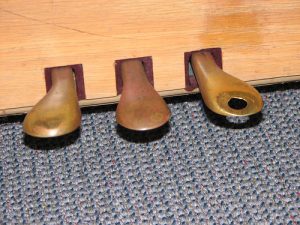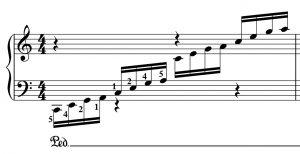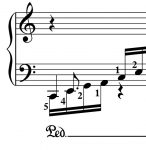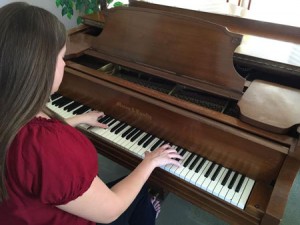Common Piano Pedal Mistakes

Even though all three piano pedals do something different, most pianists use just one: the sustain pedal, also called the damper pedal. This pedal makes the keys echo with a ringing tone, sustaining the sound even after you let go of the keys. It adds a rich and beautiful quality to the sound of your music.
Pianists use this pedal so much more than the other two that we tend to just call it “the pedal.” You’d think that with so much favoritism, pianists would be really good at using the sustain pedal.
Not always.
The truth is, there are several common mistakes that pianists make with the damper pedal. If you want to know to how to use the sustain pedal, you have to know what mistakes to avoid. Here are some of the worst offenders and what you should do instead.
Not Paying Attention to the Pedal
When playing piano, you’re probably paying more attention to your fingers than your foot. If you’re not consciously paying attention to your foot as well as your fingers, you risk making all the following mistakes.
What to Do Instead: This is an easy one: pay closer attention to how you use the sustain pedal! This will help you become a better pianist and make your music more beautiful. (At least you usually only have to worry about the one pedal—be grateful you’re not playing an organ!)
Too Much Pedal
The sustain pedal gives the music a rich, ringing echo, so you should use it all the time, right? Wrong! While some pieces of music need the pedal most or all of the time, many only call for pedal in certain places. And some don’t even need the pedal at all and would honestly sound bad if you were to use pedal while playing them.
What to Do Instead: Respect the integrity of the music, and don’t overuse the pedal. If the music says “no ped.”, or if the pedal doesn’t enhance the sound, you shouldn’t be using it.
Not Enough Pedal
If you don’t use pedal where you should, your music will lack some of the finer elements of sound. Your fingers may sound technically correct, but you’ll lose the proper feel for the song. As an example, Clair de Lune wouldn’t sound nearly so smooth and elegant without strategic use of the pedal.
What to Do Instead: The piano pedal is meant to be used and can give your music a beautiful resonance. Use it when appropriate to add to your sound. (Just don’t overdo it.)
Failing to “Clear” the Pedal
“Clearing” the pedal is what we call it when you lift and depress the pedal again.
Some amateur pianists never lift their foot, so the pedal is never cleared. And some pianists clear the pedal occasionally, but not often enough. The problem here is that the pitches of all previous keys played carry into the next musical phrase. This blends everything together into a muddled or “muddy” mess, creating a messy cacophony of sound instead of beautiful music.
Just as bad, some offenders only lift their foot part of the way. This will only partially “clear” the pedal, so you’ll still hear some resonance hanging over from the previous phrases.
What to Do Instead: There are two solutions here. First, when you clear the pedal, do so completely every time by lifting your foot high enough that the pedal reaches the top of its hinge before you press it down again. Second, study with a teacher to learn how and when to clear the pedal. If you can’t work with an instructor, follow the instructions on the sheet music. If none are provided, one general rule is to clear the pedal at least once every chord change. For example, if your accompaniment pattern switches from a C Major chord to a G Major chord, clear the pedal right when changing chords. (There are other important rules about pedal usage as well, best learned in piano lessons.)
Not Keeping Your Heel on the Ground
You should not pick up your whole foot every time you clear the pedal; this is an awkward movement that is sure to put you on edge and makes your playing sound choppy. If you do this, you’re also making it harder on yourself because you’re lifting your whole leg each time.
What to Do Instead: The proper way to use the pedal is to keep your heel on the ground in front of the pedal. Rest the ball of your foot (closer to your big toe, where you have more control) directly on the front part of the pedal. When it’s time to clear the pedal, lift the front of your foot off the pedal while keeping your heel on the ground. Your leg does not need to move at all. This will allow the pedal to clear completely, and your foot only has to move a little. This keeps your pedaling smooth and controlled.
If your heel doesn’t reach the ground, you may have to change how you sit on the bench (especially if you’re shorter in height). Sit on the front edge of the bench so your heel can comfortably rest on the ground in front of the pedal.
Pedaling Too Early
Pedaling early leaves a gap between the previous notes and the next ones. This gap sounds almost like a musical “stutter,” or like your sentence has been cut……off in the middle (just like that). This is a VERY common problem among beginner to intermediate level pianists; in fact, the vast majority of piano students seem to go through a phase of pedaling too early before learning to time it just right.
What to Do Instead: Quickly clear the pedal at the same moment (or just a hair AFTER) your fingers press the keys for the next chord/note. If it is early instead of at the same moment (or just barely after), there will be a disconnect or gap in the sound.
Pedaling Too Late
Pedaling too late does the opposite: it carries the sound from the previous phrase or chord into the next one. This makes your music sound “muddy” or muddled. You lose the clarity of sound, and you can lose track of the melody, harmonies, and chords.
What to Do Instead: Again, quickly clear the pedal at the same moment (or just a HAIR after) your fingers press the new keys.
Pedaling Too Slowly
If your foot is taking a whole beat or even half a beat to clear the pedal, you’re pedaling too slowly. This also creates gaps in the sustained sound.
What to Do Instead: The movement of your foot should be a quick and smooth up-and-down motion, with as minimal time to fully clear the pedal as possible. (Unless the music is written to have a gap in the pedal, in which case you should lift it and not depress it again until the music indicates.)
Not Practicing the Pedal
Using the pedal seems so simple, like pressing a button–and yet, as shown here, it’s not. Just like every other part of studying music, using the pedal takes practice. Too many pianists don’t take this seriously.
What to Do Instead: You have to practice when to use the pedal, when not to use it, and how to use it properly in order to become skilled at using the pedal.
Practicing Only with Pedal
One saying among piano teachers is that “the pedal covers a multitude of sins”. This basically means that amateur pianists sometimes depend on the beautiful resonance to hide their sloppy playing technique. But your music should always sound good and technically correct even when you DON’T use the pedal. The pedal will make a lot of things sound even better, but music should still sound good without it.
Pretty much every one of my piano students has gone through this phase of letting the pedal cover up sloppy playing. (I used to do this myself!) And trust me…your listeners CAN hear the difference.
What to Do Instead: While learning music, practice both with and without the pedal. Without the pedal, the music won’t sound quite as rich and full, but if your fingers are playing well, the music should otherwise sound just as beautiful. Even more importantly, stripping away the pedal while practicing helps you hear the details better. You’ll probably discover that certain passages still need improvement and you didn’t even realize it because of the pedal.
Hiding Behind the Pedal
By this, I mean you let the pedal make excuses for you. For instance, your sheet music has a whole note with a pedal mark, so you press the keys for 1 beat and then take them off the keys, letting the pedal do the rest of the work. Or, your sheet music has run of eighth notes and you let all your fingers stay down after playing each one, because you figure if they’re ringing anyway it doesn’t matter. (Actually, it does!)
Even some more advanced pianists make mistakes like this.
Here are two examples:

 Example 1: Arpeggio Passages
Example 1: Arpeggio Passages
Left image: This hand-over-hand arpeggio passage is written to be played with the pedal. Leaving the Left Hand 4 and 5 fingers pressing down on the keys is a common mistake, because they’re weaker fingers and tend toward laziness. But if the composer wanted you to do that, he or she might have written it to look something like the image on the Right.
There IS an audible difference when you lift your fingers vs. when you let the keys stay pressed. It all has to do with the resonance of the piano strings, the dampers on the piano, harmonics, and the physics of sound. As you become more advanced in studying piano, your trained musical ears can learn to detect the difference in the way these two passages sound (even when you’re pressing the pedal).
Example 2: Für Elise
See the rests in the Left Hand between the first and second Pedal marking? This means that the pianist should release the LH fingers from the keys, but continue to hold the pedal. This will create a different, lighter sound than if the LH were to linger on these keys through the rests.
What to Do Instead: Remember to lift your fingers when the music tells you do, and practice without the pedal to make sure you’re doing it right. If you don’t practice without the pedal, you don’t become aware of these distinctions as early in your musical study. The most important takeaway from these two examples is that an experienced musician can hear the difference, and the composer wrote it that way for a reason.
Not Listening to Yourself
It’s really tempting to be lazy with the pedal. Since the sustain pedal causes so many notes to resonate at once, it’s easy to let your fingers become sloppy with their technique. Many pianists don’t even realize how lazy they’ve become because they’re not really listening to themselves when they play. But an experienced musician will always be able to tell when your technique is clean, even through the guise of the pedal. Actually, most listeners can tell a difference!
What to Do Instead: Listen. Always listen. If you’re concentrating so intensely on reading the music and playing the right keys that it’s too hard to listen, then you need to keep practicing until you know the music better and it becomes easier, more like second nature. Listening is an essential skill for every musician.
Learning to Use the Sustain Pedal
It’s hard for the pianist using the pedal to hear all these mistakes. Usually you’re focusing so much on reading the notes that you aren’t listening critically to yourself, or you’re making the first mistake of not paying enough attention to the pedal.
If you’re not very good yet at using the pedal, don’t be discouraged. Skills take time! Use this opportunity to critically analyze your pedaling technique, follow these tips on how to improve, and you’ll become a much better pianist and musician. Ask your piano teacher for help or sign up for piano lessons to get expert assistance in improving your technique.
Without clean pedal technique, your music will never sound as good as it could. But when you know how to use the sustain pedal correctly, it will transform your performance and allow your music to transcend to greater heights.

